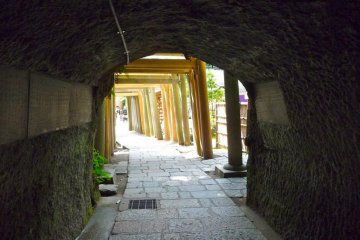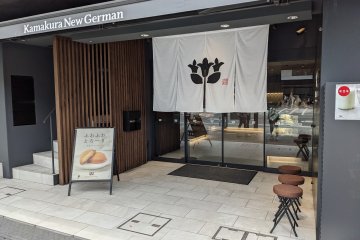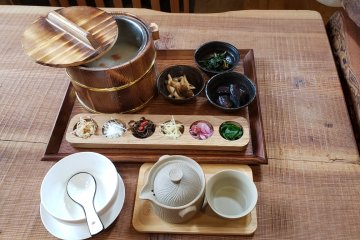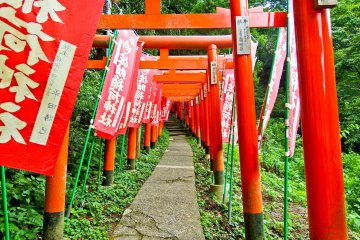
ศาลเจ้า Zeniarai Benzaiten ในคามาคุระ
Adeline Ongศาลเจ้า Zeniarai Benzaiten Ugafuku Jinja เป็นศาลเจ้าชินโตในเมืองคามาคุระ และเป็นที่ตั้งของน้ำพุธรรมชาติอันศักดิ์สิทธิ์ของเทพเจ้าอุงะฟุกุจิน
Zeniarai Benzaiten Ugafuku Shrine, popularly known simply as Zeniarai Benten, is a Shinto shrine in Kamakura, Kanagawa, Kanagawa prefecture, Japan. In spite of its small size, it is the second most popular spot in Kamakura, Kanagawa prefecture after Tsurugaoka Hachiman-gū. [Wikipedia]

ศาลเจ้า Zeniarai Benzaiten Ugafuku Jinja เป็นศาลเจ้าชินโตในเมืองคามาคุระ และเป็นที่ตั้งของน้ำพุธรรมชาติอันศักดิ์สิทธิ์ของเทพเจ้าอุงะฟุกุจิน

ไทเซน-คาคุเป้นโรงเตี๊ยมอายุ 100 ปี และอยุ่ติด ๆ กับวัดฮาเสะ คันนอนเลย บริการของที่นี่จะเป็นประสบการณ์อันน่าประทับใจของคุณที่คามาคูระ

ทานอาหารกลางวันที่ The Scapes ลิ้มลองสลัดผัก สเต็กเนื้อนุ่ม และของหวานอร่อยๆ ท่ามกลางบรรยากาศและทัศนียภาพอันงดงาม

ถ้าคุณมาที่ฮานามะ โฮเต็ล โอโตว่า โนะ โมริ วิธีที่ดีที่สุดที่คุณจะใช้เวลาอาจจะเป็นการที่ไม่ทำอะไรเลย แค่พักผ่อนอย่างเดียว ที่นี่คุณสามารถหาบรรยากาศของรีสอร์ทอย่างแท้จริงได้!

ค้นพบรสชาติที่ชาวบ้านคามาคุระหลงใหล ใหม่เค้กสปันจ์คัสตาร์ดเนื้อนุ่มของเยอรมันเป็นของหวานที่จะสร้างความประทับใจอย่างแน่นอน รสคัสตาร์ดคาราเมลเป็นที่นิยมอย่างมากในหมู่นักท่องเที่ยว

ลิ้มรสหมูทอดที่มีชื่อเสียงของอะราทามา และคุณจะตกหลุมรักกับรสชาติอันสดใหม่ ที่นี่ไม่ได้มีเพียงเมนูทงคัตสึเท่านั้น อย่าลืมลิ้มลองอาหารเมนูอื่นๆ ของอะราทามา เช่น มอซซาเรลลา เมนชิ คัตสึ และครีม โคร็อกเกะ

ใช้ผลิตภัณฑ์ปลอดจากสัตว์ ข้าวกล้อง และผักสดที่มาจากท้องถิ่น ที่คิ-โทะ-โทะคิ รังสรรค์อาหารมังสวิรัติชั้นเยี่ยมที่ไม่เพียงแต่อร่อย แต่ยังดูเพลินอีกด้วย มาลองชุดอาหารและเครื่องดื่มหมัก 17 ชนิดพร้อมของหวานและชาสมุนไพร หรือกาแฟหลังอาหารกันเถอะ

Sasuke Inari Shrine is a Shinto shrine in Kamakura and the site of the Hidden Village of Kamakura. It is located very near the Zeniarai Benzaiten Ugafuku Shrine. [Wikipedia]

Tokeiji, a Rinzai-sect temple of Zen Buddhism, is a branch temple of nearby Engakuji, which is a short 5-minute walk away. This important temple/nunnery was founded in 1285 by the wife of regent Hojo Tokimune as a sanctuary for women who were abused by their husbands. In a time when women could not legally divorce, Tokeiji offered them a three-year training program in return for an official divorce. The temple’s right to issue divorces was revoked in the early 1870s and its time as a nunnery ended in 1902. Up until 1902, men were strictly forbidden from entering the premises. Today, all visitors are welcome, and the temple is known for its beautiful flower gardens from summertime hydrangeas to wintertime plum blossoms. The relatively small complex features multiple structures, including an entrance gate, a bell tower, tea houses, a treasure house, and a main hall. The treasure house holds Buddhist artifacts, as well as lacquer work from past nuns; and the main hall enshrines a seated statue of Shaka Nyorai, the principal image of the temple. Join the temple for early morning zazen meditation, which is held every Sunday.

Kotoku-in is the more common name for Taiizan Kotoku-in Shojosen-ji in Kamakura, Kanagawa Prefecture. This Jodo-shu Buddhist temple is known for its Daibutsu, or great Buddha, which is one of the most famous icons of Japan. The statue, commonly known as the Kamakura Daibutsu (Big Buddha of Kamakura), is a colossal copper image of the Amitabha Buddha. The Buddha, which was declared a national treasure by the Japanese government, is about 11.3 meters high and weighs about 121 tons. The Kotoku-in belongs to the Jodo sect, a traditional Buddhist sect founded by the priest Honen (1133-1212) who was a follower of Amitabha. According to the Jodo sect's belief system, all people are equal and one only has to sing the "Nenbutsu" to receive the protection of Amitabha and to be reborn in one's "pure land".